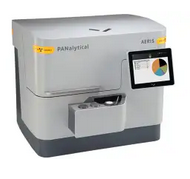Aeris XRD for pharma
Solid form analysis for pharmaceutical development and production
Partner with Malvern Panalytical and safeguard your pharmaceutical development and manufacture.
Is solid form characterization critical in your line of work, but you lack expertise in X-ray diffraction (XRD)? Do you need an efficient tool to support you with lead optimization? Do you need an easy way to validate the stability of your solid form following processing?
Are you worried about unexpected production issues, or about maintaining drug product quality? Would you like to de-risk your manufacturing processes and have confidence in your ingredients and products?
Put your mind at rest: partner with Malvern Panalytical and choose Aeris – the world’s leading benchtop X-ray diffractometer! Aeris is small enough to fit your workspace and workflow, but BIG on performance and throughput.
Drug discovery and lead optimization are the first steps needed to enable a successful drug product to get to market. The key here is to identify compounds that bind to the identified target protein with the desired characteristics, and to assess the likelihood for manufacturing success - being able to process and formulate the candidate molecule into a drug product in an efficient manner.
Due to the complex nature of molecule discovery, there is a high risk of failure, when compounds do not behave as expected, do not have the required activity, or show issues during development.
Malvern Panalytical’s toolset of physicochemical analysis solutions aids researchers to make informed decisions about how the characteristics of the molecules and materials they are working with impact on their behavior. Our technologies and expertise help ensure decisions are based on the best possible data: they help monitor and optimize sample and assay conditions, and validate hits from high throughput assays or fragment-based screening. This assists in building a more informed picture of the interaction between lead molecules and target protein in terms of structure activity relationship (SAR) and underlying interactions. Malvern Panalytical solutions can also elucidate the crystalline structure of the API to enable patenting and future optimization of the new chemical entity (NCE).
Quality control for assay development
To be confident in your results you need robust and repeatable data. This is where Malvern Panalytical can help you in a number of ways, starting with understanding the quality and stability of assay components such as reagents, proteins or compounds. Reagent control is the basis for good assay development, and reagent stability, purity and functionality must be considered to achieve a robust assay.
Watch the short videos, in the related content below, to see how our solutions can help with the following:
Make sure your target protein is in good condition
When screening many compounds; for example, in a biosensor assay, it is critically important that the target protein is active and stable under assay conditions. An unstable or inactive target protein could compromise the assay, resulting in costly screening iterations and potentially even false negative results.
Address solubility issues with low molecular weight ligands
Solubility issues for low molecular weight (LMW) ligands can also create quality issues in screening activities. Problems with solubility can affect binding data and make your ligand-ranking less reliable.
Ensure all batches of target proteins are the same
Find out how Isothermic Titration Calorimetry is used in quality control of different target protein batches.
Enzymes play a special role by catalyzing chemical reactions in the human body through binding to molecular substrates and modifying them in specific ways. Enzymes are important in drug discovery and development, as approximately half of current drug targets are enzymes. A lot of effort is put into discovery and characterization of enzymatic pathways and enzyme activity as well as developing drugs that interact with enzymes
Enzymatic assays are among the most frequently performed activities in biochemistry and typically require use of labeled substrates and coupled reactions with spectrophotometric or chemical readout. Isothermal titration calorimetry (ITC) offers a direct and generic way of following the rate of enzymatic catalysis through the heat rate associated with enzymatic reactions. Enzymatic assays in ITC can be run with opaque solutions at enzyme concentrations comparable to that used in biochemical assays and can yield a complete set of kinetic parameters in a single experiment.
Validation of hits from primary screens
The hits generated by the high- and medium-throughput screening assays used in the early stages of drug discovery need validation to ensure they aren’t false positives; for example, if they interact with a biochemical assay instead of the target protein. Isothermal Titration Calorimetry (ITC) can be used to confirm and quantify binding and to establish binding stoichiometries, so that false positives and non-stoichiometric binders can be discounted and not waste resource as the project progresses.
Mechanism of action analysis
Mechanism of action (MOA) analysis helps develop the understanding of structure-activity relationships (SARs) for the target and any ligands.
Isothermal Titration Calorimetry (ITC) is the gold standard technique for confirmation of the ligand’s direct binding to the target, measurement of co-factor binding, and differentiation between competitive, non-competitive and uncompetitive binding, as well as determination of the interaction stoichiometries. ITC provides a rapid thermodynamic characterization of the binding event.
Lead optimization
After fragment-based screening, the next step is understanding how to build on the fragment with different chemical functions to optimize the binding affinity of the compound. For this type of research, some analysts are using
Isothermal Titration Calorimetry (ITC) to complement and guide SAR studies. This enables investigation of the entropy and enthalpy of the interaction between the compound and the target protein, which can inform us about changes in hydrogen bonds and hydrophobic interactions in the binding pocket, depending on which functional groups are added to the fragment.




